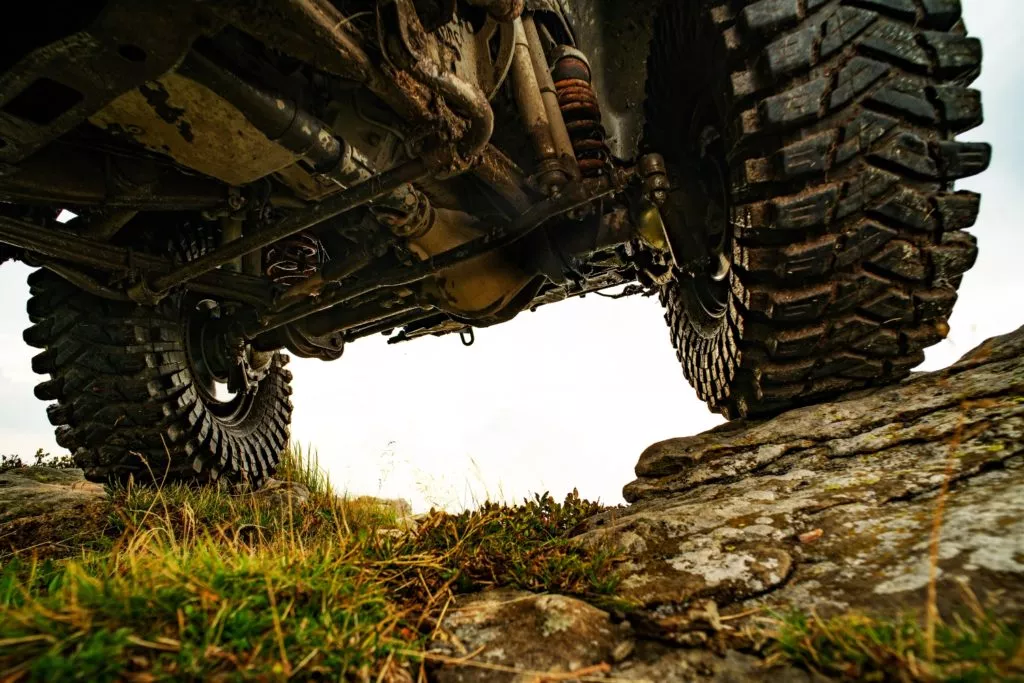While you’re perusing vehicles for sale online, you might notice that some trucks and SUVs are 4×4, while others are 4×2. What do the terms 4×4 and 4×2 mean, and which option should you choose for your next vehicle?
What’s the Difference Between 4×4 and 4×2?
Before we jump into what differentiates 4×4 and 4×2 vehicles from one another, it’s important to understand the difference between drive wheels and non-drive wheels.
- Drive wheels transfer tractive force (derived from the engine’s rotational force) to the road, causing the vehicle to move.
- Non-drive wheels are just along for the ride—they do not transfer tractive force to the road.

Trucks and SUVs often come in both two-wheel drive (4×2) and four-wheel drive (4×4) configurations.
- Two-wheel drive (4×2) vehicles have two drive wheels and two non-drive wheels.
- Four-wheel drive (4×4) vehicles have four drive wheels.
Let’s take a closer look at both designs.

What is 4×2?
The term 4×2, which means that the vehicle is two-wheel drive, is generally used to describe rear-wheel drive trucks and SUVs.
With a rear-wheel drive layout, rotational force from the engine is transferred from the transmission to a driveshaft, which connects to the differential and the rear wheels. The rear wheels transfer tractive force to the road, thereby setting the vehicle into motion.

Note: You may also see the term two-wheel drive written as 2WD.
What is 4×4?
Many trucks and SUVs are four-wheel drive (4×4). Most four-wheel drive systems are part-time, meaning the driver can switch the vehicle from two-wheel drive to four-wheel drive on demand. The four-wheel-drive system is usually engaged by pressing a button or pulling a lever. There are also some applications that have a full-time four-wheel drive system in which all four wheels are continuously driven.
In a typical four-wheel drive system, rotational force from the engine is transferred from the transmission to a transfer case. The transfer case connects to two driveshafts: one that goes to the front differential and one that goes to the rear differential. Each of the differentials turns a set of drive wheels whenever the four-wheel drive system is engaged.

Note: You may also see the term four-wheel drive written as 4WD.
Which is Better: 4×4 or 4×2?
Whether four-wheel drive or two-wheel drive is a better choice will depend on how you plan to use your vehicle.
The advantages of a four-wheel drive system include:
- 4×4 vehicles can drive all four wheels for increased traction when traveling over challenging terrain.
- 4×4 vehicles often have a higher towing and payload capacity than 4×2 vehicles.
- 4×4 vehicles generally have a higher resale value than 4×2 vehicles.
The advantages of a two-wheel drive system include:
- 4×2 vehicles typically weigh less and are more fuel-efficient than 4×4 vehicles.
- 4×2 vehicles usually cost less than 4×4 vehicles
- 4×2 vehicles have fewer parts and cost less to maintain than 4×4 vehicles.

Because four-wheel drive can route power to all four wheels, the design provides excellent traction, making it ideal for traversing challenging terrain. If you travel off-road or through heavy snow, 4×4 is the way to go.
Meanwhile, two-wheel drives have only two drive wheels—an arrangement that provides limited traction. For this reason, 4×2 vehicles aren’t typically recommended in low-traction situations, such as traveling off-road or navigating deep snow.
One perk of 4×2 vehicles, however, is that they usually weigh less (because they have fewer parts) than their 4×4 counterparts. That reduction in weight makes two-wheel drives more fuel-efficient than four-wheel drives.
Two-wheel drives also usually cost less to purchase and maintain than four-wheel drives. If you’re looking at two versions of the same vehicle—one that’s 4×2 and one that’s 4×4—the 4×2 variant will almost always be less expensive to purchase and own.
The downside is that 4×2 vehicles often have a lower resale value than those with 4×4. Two-wheel drive vehicles also tend to have lower towing and payload capacities than those with four-wheel drive.

4×2 vs. 4×4 Truck: Which Should You Choose?
Should you choose a two-wheel drive or four-wheel drive for your next vehicle? The answer to that question will depend on your lifestyle.
If you don’t need the additional traction that a 4×4 vehicle provides, going with a 4×2 is often the best choice. Two-wheel drives cost less and are cheaper to own than four-wheel drives.
Be realistic when making your decision—do you really need the capability of a four-wheel drive vehicle? Weigh the pros and cons of both options and decide which choice is best for you.
Where to Get a New Driveshaft for Your Vehicle
It’s recommended to stop driving your vehicle if its driveshaft makes abnormal noises, vibrates, or fails. Ignoring the symptoms can lead to transmission problems, which are costly and time-consuming to repair. Fortunately, CarParts.com can help you get a replacement driveshaft with the best fit for your car or truck.
When you’re shopping online for driveshafts at CarParts.com, there’s no need to guess if the new part will fit your vehicle. Plug the year, make, model, and engine of your car or truck in the vehicle selector of our website, and the search results will show the most compatible products in our catalog of parts and accessories. Furthermore, we always source our driveshafts from trusted manufacturers, so you know you’re getting long-lasting parts that deliver the performance required by your application. Ordering a new part takes only several clicks, and your new driveshaft takes only several business days to arrive if you live in the continental U.S. and order before noon ET.
Replace the faulty driveshaft before it fails. Check out our wide selection of quality driveshafts now at CarParts.com.
Any information provided on this Website is for informational purposes only and is not intended to replace consultation with a professional mechanic. The accuracy and timeliness of the information may change from the time of publication.





























